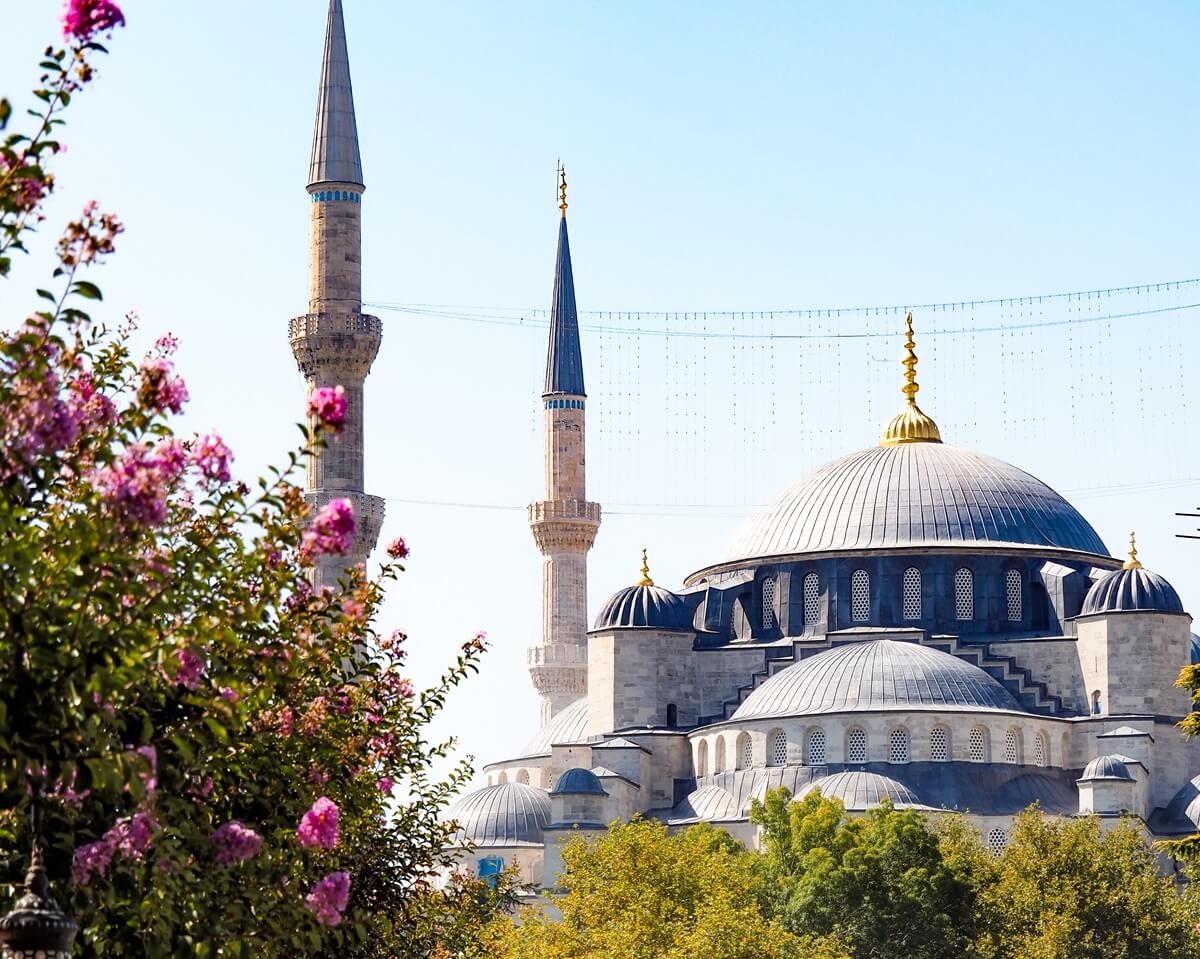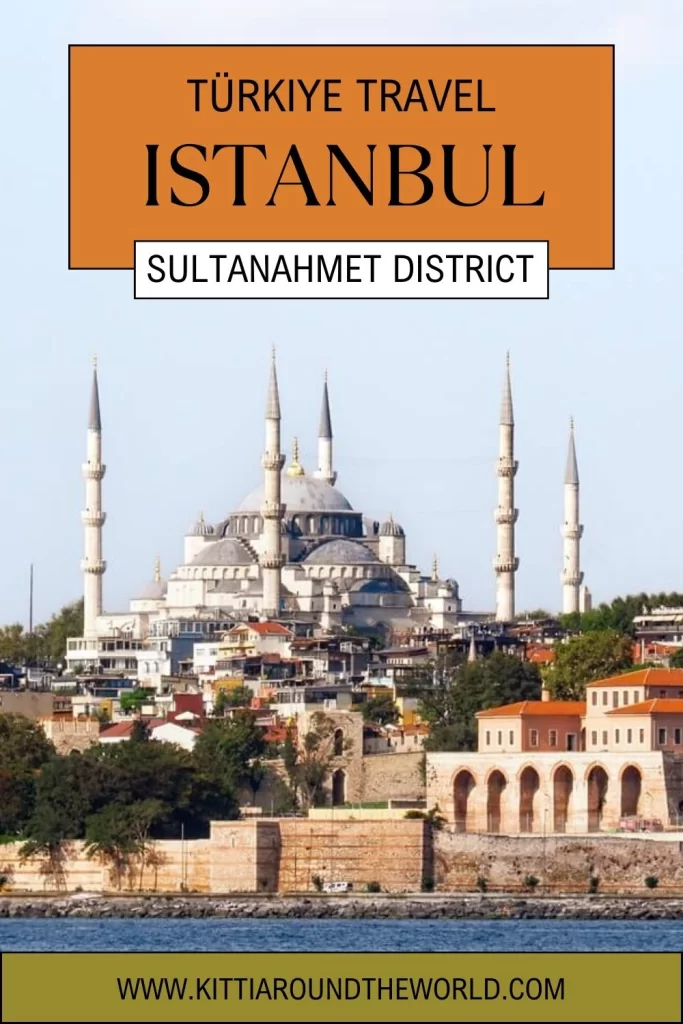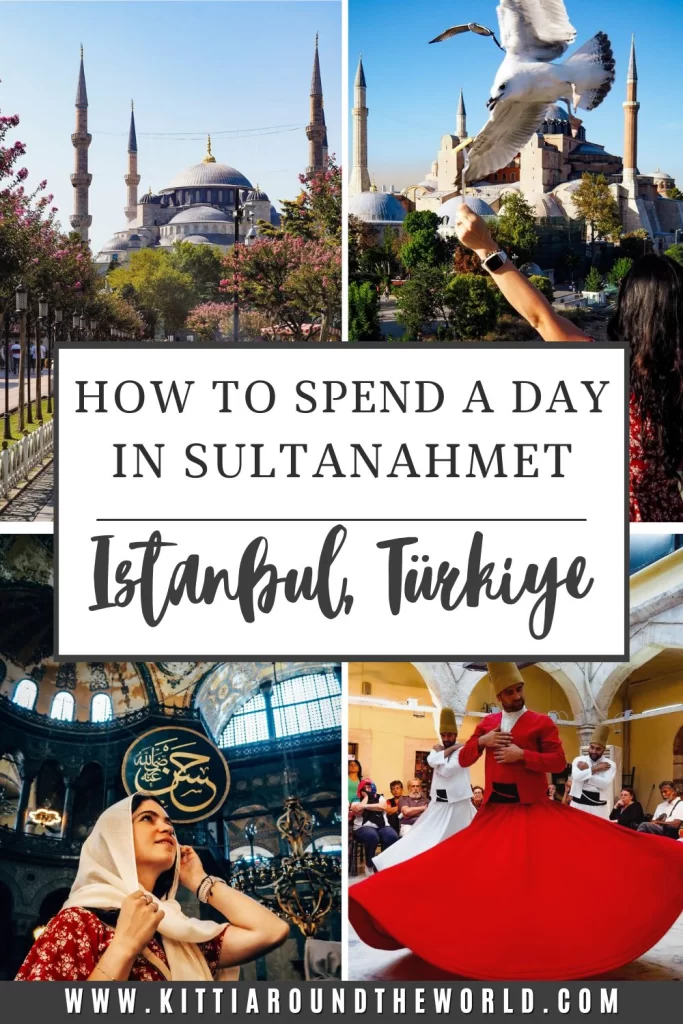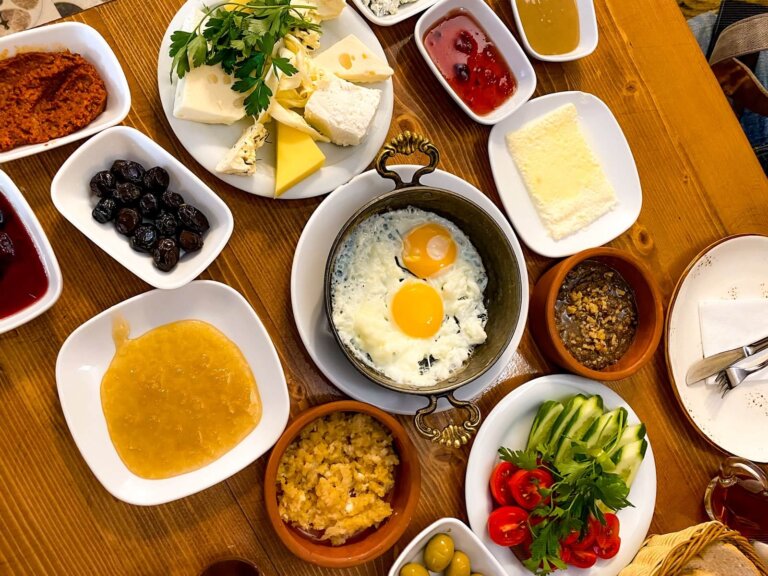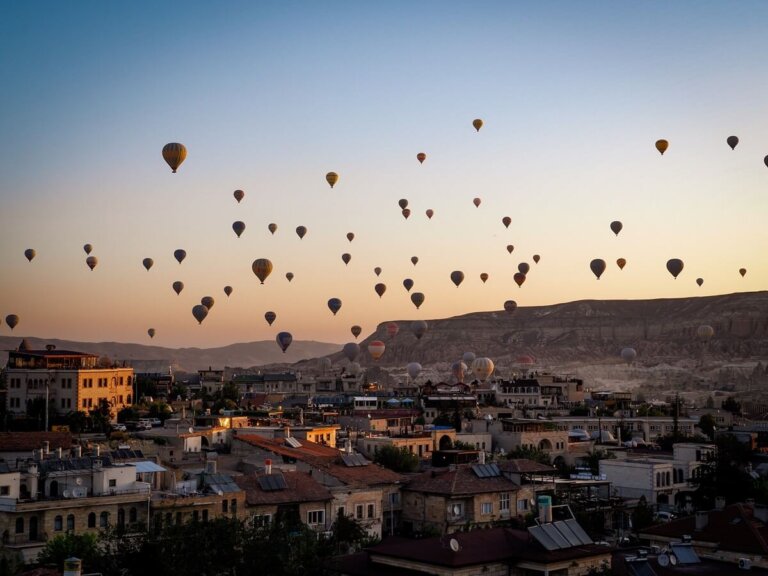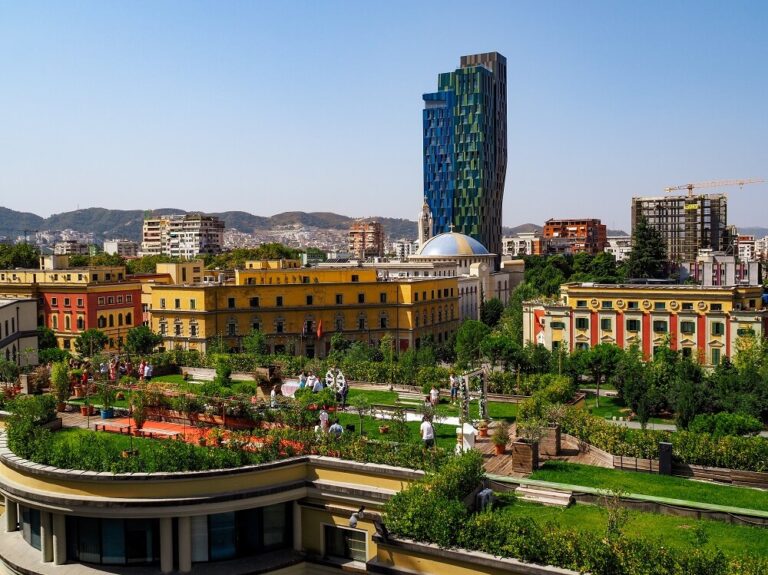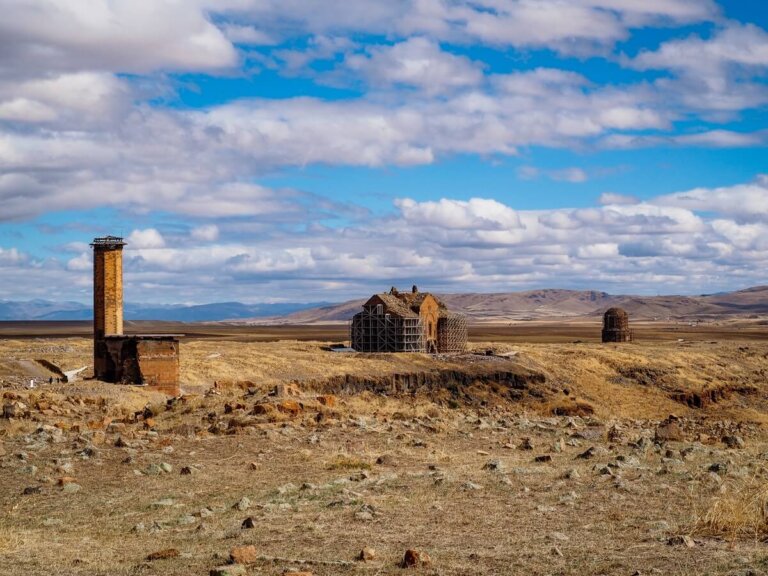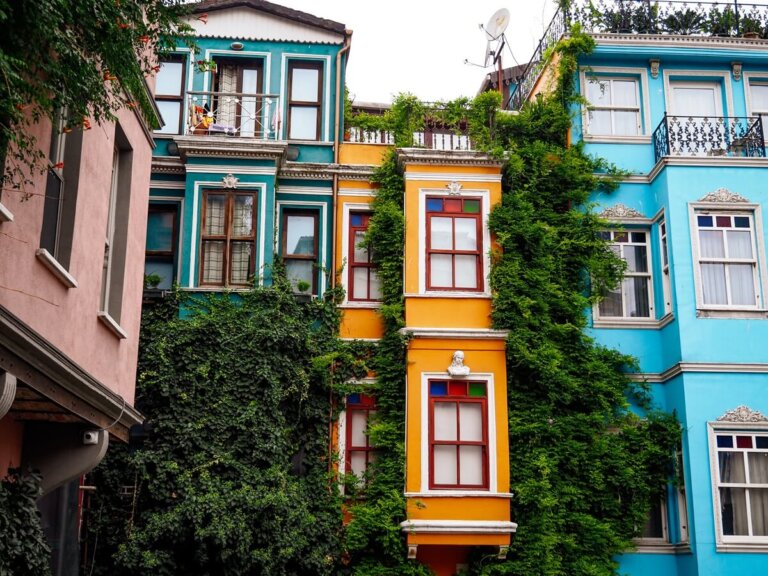Things to Do in the Sultanahmet Neighbourhood of Istanbul, Turkey
You cannot visit Istanbul without spending some time in the Sultanahmet neighbourhood of the city. Also known as the ‘Old City’, this part of Istanbul is filled with some of the city’s most iconic landmarks, such as the Blue Mosque and Hagia Sophia.
If you’re planning a trip to Istanbul, then in this guide you’ll find all the places you could consider visiting in the Sultanahmet neighbourhood during your stay. We recommend spending a minimum of 4 days in Istanbul because the city is packed with so many things to do. You could easily spend the majority of your day in this one area alone, or combine it with a visit to another district, such as Beyoglu or Balat.
Disclosure: This post may contain affiliate links, which means we may receive a small commission if you click a link and purchase something. Clicking these links won’t cost you anything, but it will help us to keep this site up and running! Learn more about our affiliate policy.
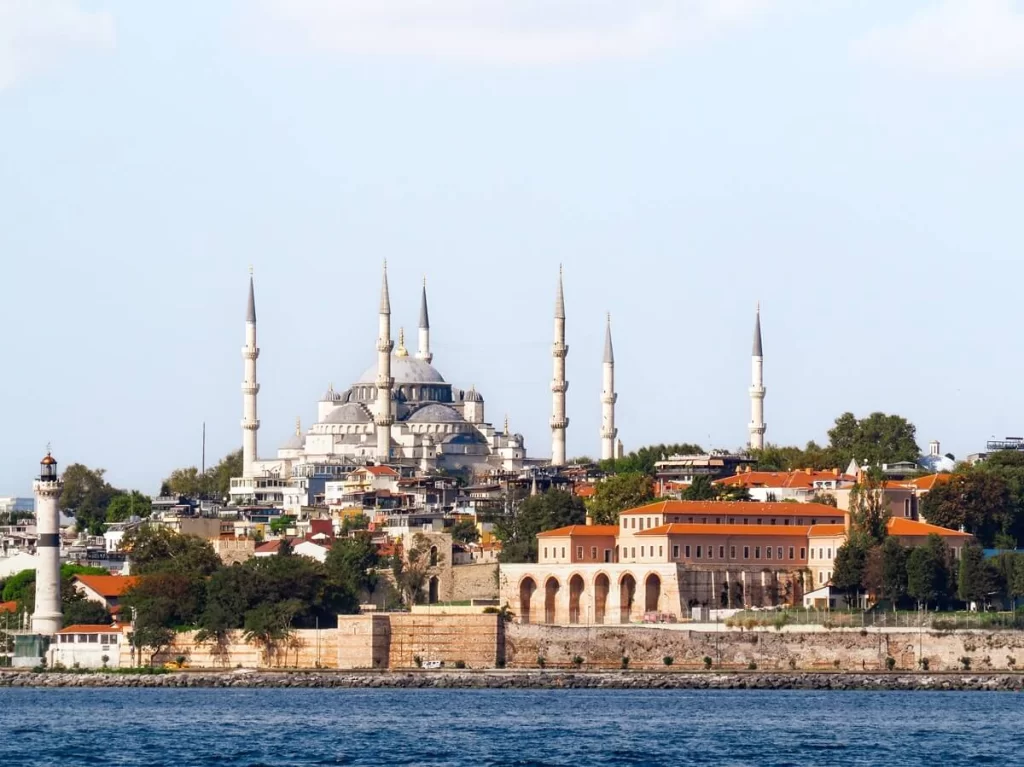
Things to Do in the Sultanahmet Neighbourhood of Istanbul
Sultanahmet, also known as the ‘Old City’, is the historic neighbourhood of Istanbul. It was named after Sultan Ahmet I, and was the center of the Roman, Byzantine and Ottoman empires. Today, it is listed as a UNESCO World Heritage Site and you can find the majority of Istanbul’s important landmarks here.
Top Tip. Consider purchasing either a Museum Pass Istanbul or a Museum Pass Türkiye card if you’re planning on visiting multiple museums and archaeological sites whilst you’re in Istanbul or Türkiye. The dedicated Istanbul pass is 105 EUR and the Türkiye pass is 165 EUR. This might sound expensive, but when you consider that entry to the Topkapi Palace Museum alone costs 1,500 TL (45 EUR) it starts to make sense. However, not everything we’ve listed below is included in these passes! See this website for more details.
Note that prices are prone to change so always check the official website for more up-to-date information.
Our Top Travel Resources to Visit Istanbul
- 🛏️ Find your accommodations with Booking.com
- 🎫 Book an organised tour in Istanbul with GetYourGuide
- 🛡️Don’t forget to buy travel insurance via SafetyWing
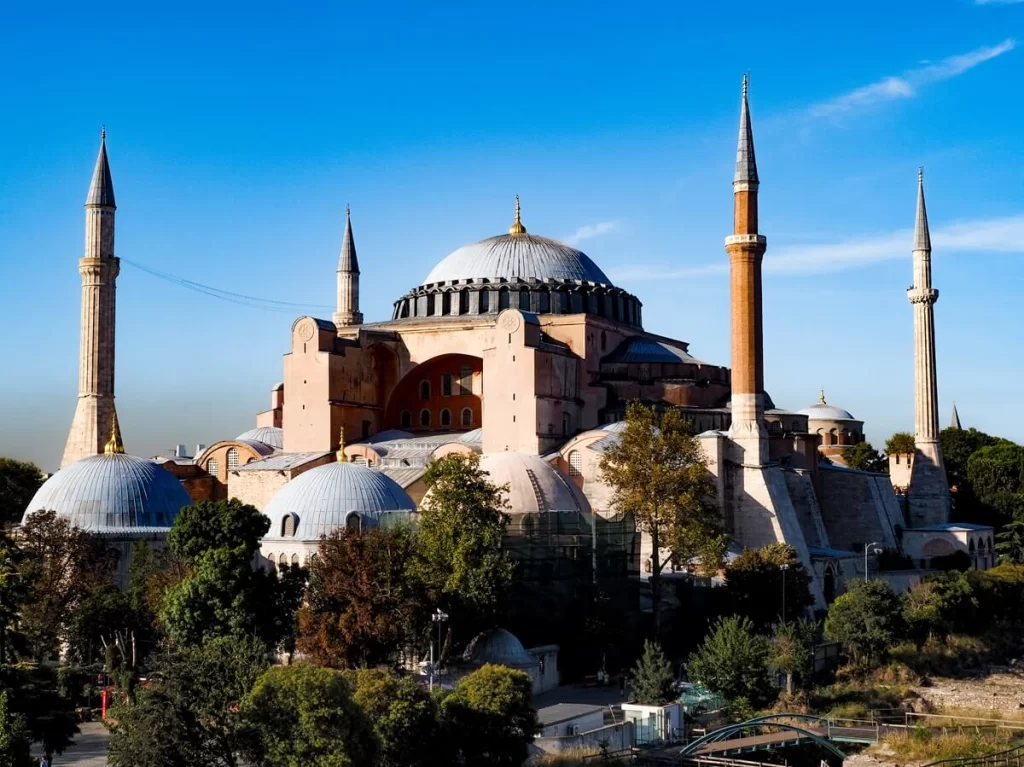
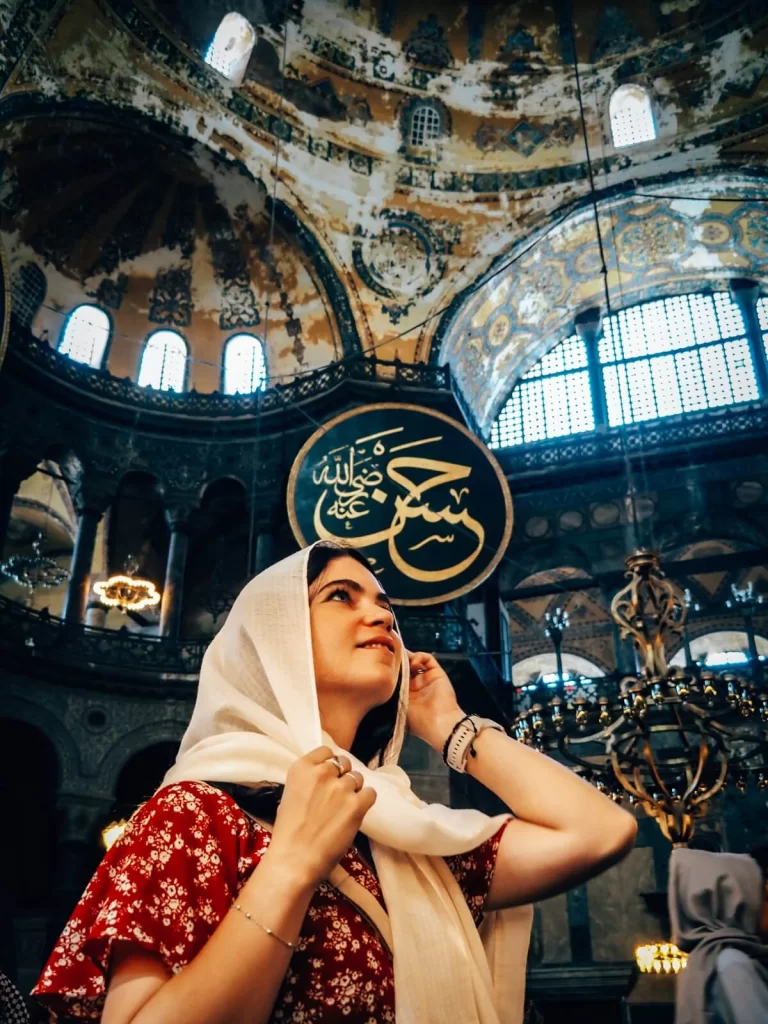

1. Hagia Sophia
Istanbul is home to 3,000 mosques, and the Hagia Sophia is definitely the most visited one in the city along with the Blue Mosque.
It was built in 537 AD and is one of the finest examples of Byzantine architecture in the world. Hagia Sophia was originally built as a church, until 1453 when Constantinople fell to the Ottomans. It then served as a mosque until 1922, and several elements were added to the structure during this time. Then, in 1934, it was converted into a museum to preserve its rich history. However, in 2020, Hagia Sophia was declared a mosque once again.
Note. You can no longer visit Hagia Sophia for free. When it was turned into a mosque again in 2020 it became free to enter. As you can imagine, the number of daily visitors increased significantly. To ease the impact of over-tourism there’s now a €25 entry fee you’ll have to pay. They’ve also restricted the areas tourists can visit and professional guided tours aren’t allowed either. You can however listen to an audio guide using your phone. Note that you still need to dress modestly and cover your hair if you’re a female as it is still a mosque. A dedicated entrance for tourists is available at the Fountain of Sultan Ahmet III.
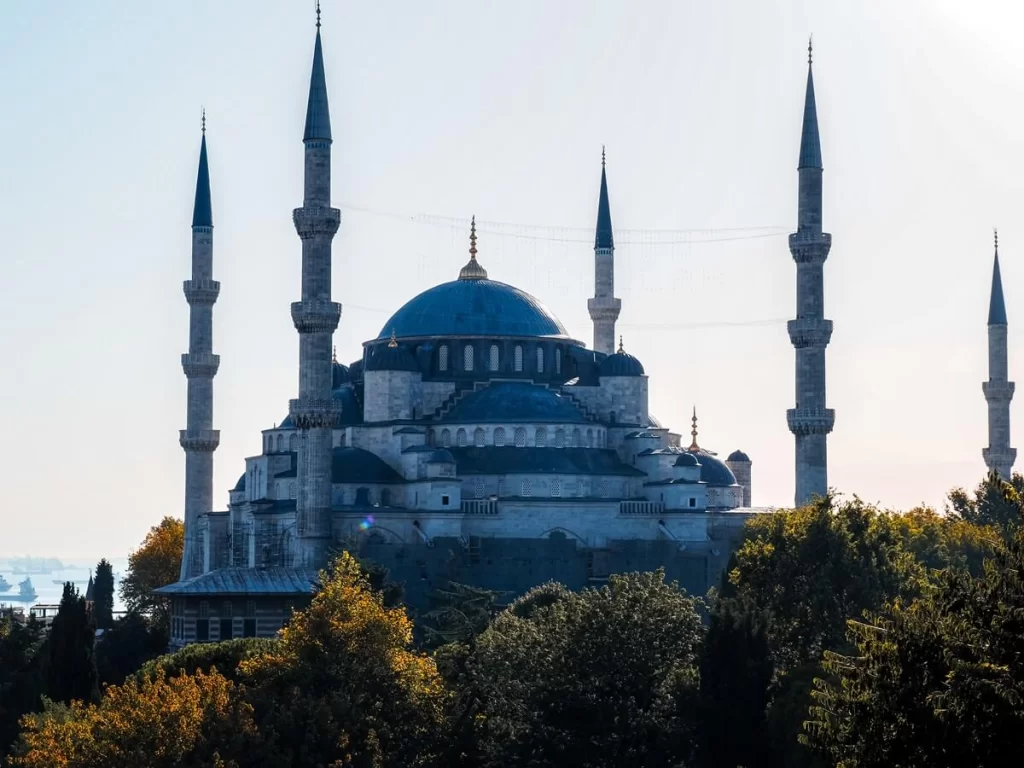
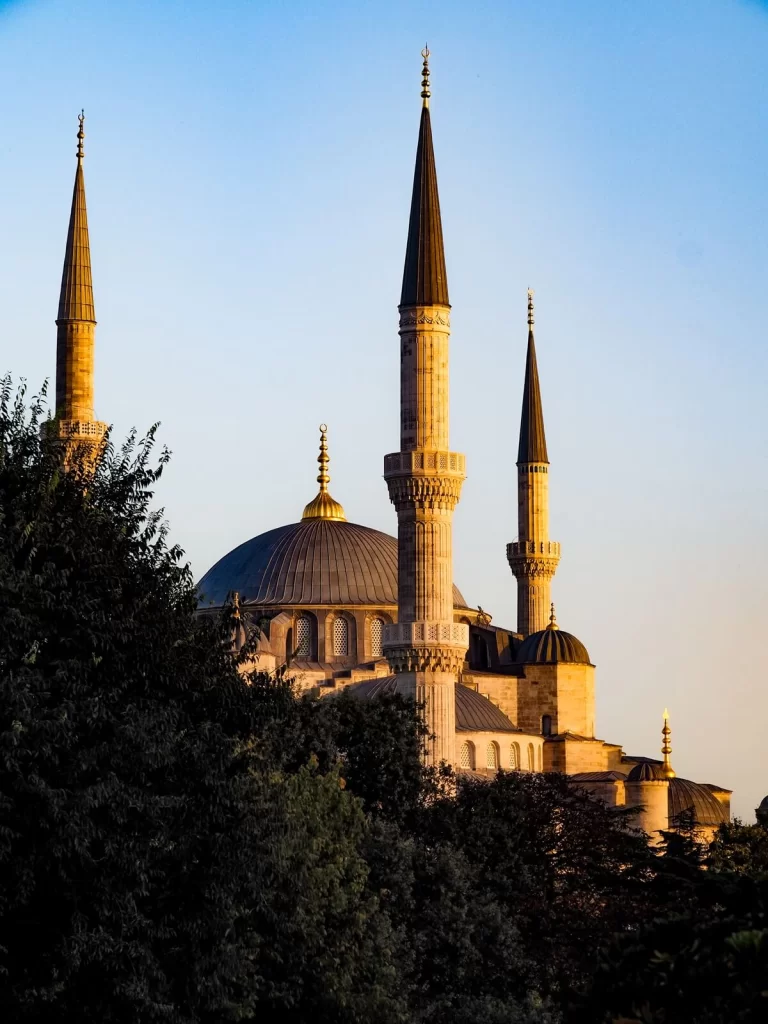
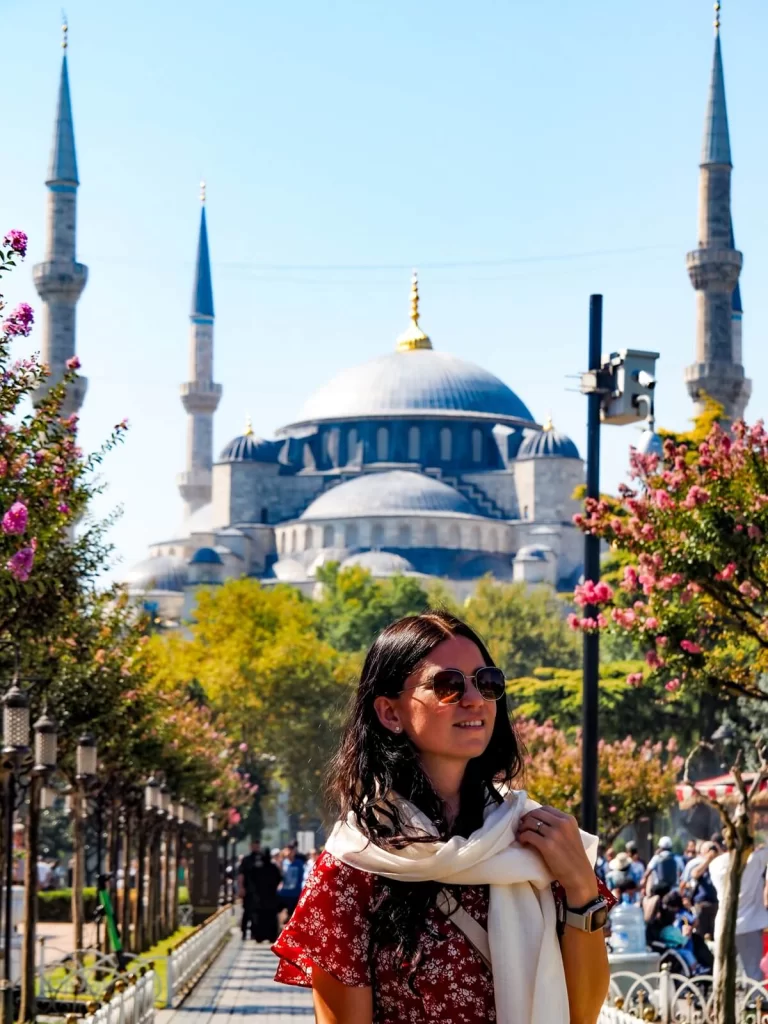
2. The Blue Mosque (Sultanahmet Camii)
The Blue Mosque, or Sultanahmet Camii, is one of the most iconic mosques in Istanbul. It should be on pretty much everyone’s itinerary, just like the Hagia Sophia.
It was commissioned by Sultan Ahmed I and built between 1609 and 1616. The mosque’s architecture is a beautiful mix of Ottoman and Byzantine styles. Some of the notable features are the huge central dome complemented by eight minor domes, and the six minarets that dominate the city’s skyline. The interior of the mosque is jaw-dropping as well. It has over 200 stained glass windows and about 20,000 handmade blue tiles, which is where it got its more commonly used name from.
Note. It is still an active place of worship. Therefore, if you want to enter, you’ll need to dress modestly and cover your hair if you’re a female.
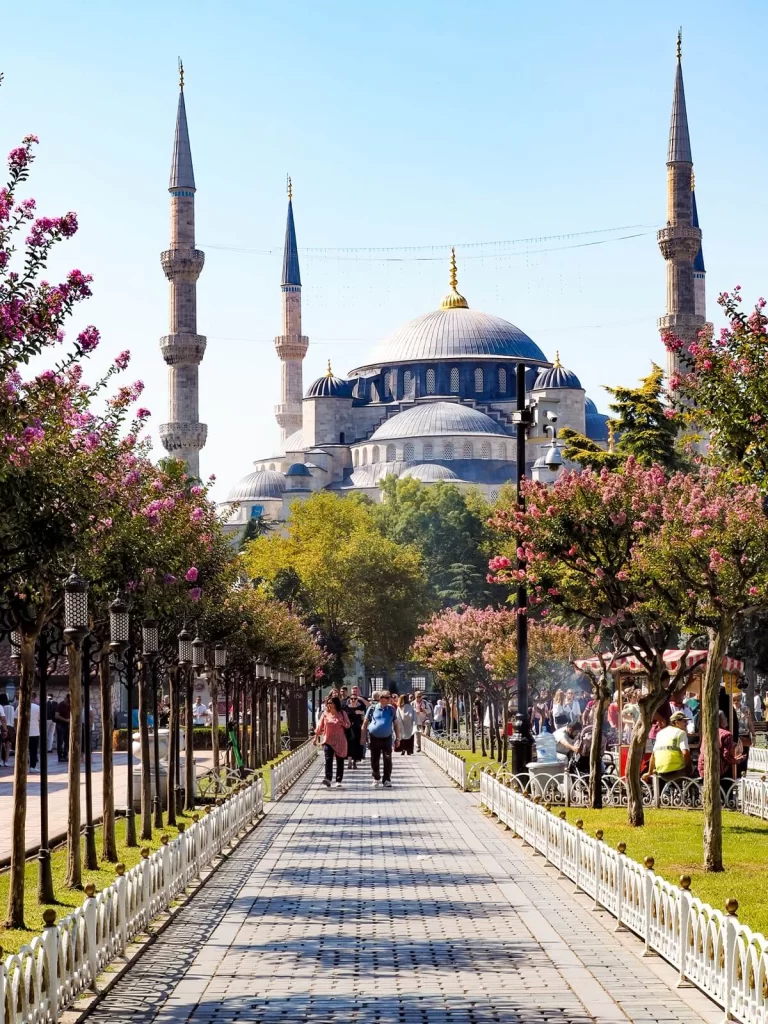

3. Sultanahmet Square and Park
After you’ve admired the interior of the Blue Mosque don’t forget to visit Sultanahmet Square too. Also known as the Hippodrome, it was once the heart of Byzantine Constantinople. It used to be a public arena for chariot races but they also held gladiatorial games, various ceremonies, festivals, and protests here.
There are 3 ancient monuments you can see in the square today: the Egyptian Obelisk, the Serpentine Column, and the Colossus.
You can also stroll through Sultanahmet Park on your way to Hagia Sophia or the Blue Mosque. From this vantage point, you can see just how huge both buildings are. There are trees, benches and a large fountain in the middle which provide a lovely spot to walk around. It can be pretty busy though. Make sure to grab some simit from one of the street vendors, a popular circular bread snack you’ll see everywhere in Turkey.
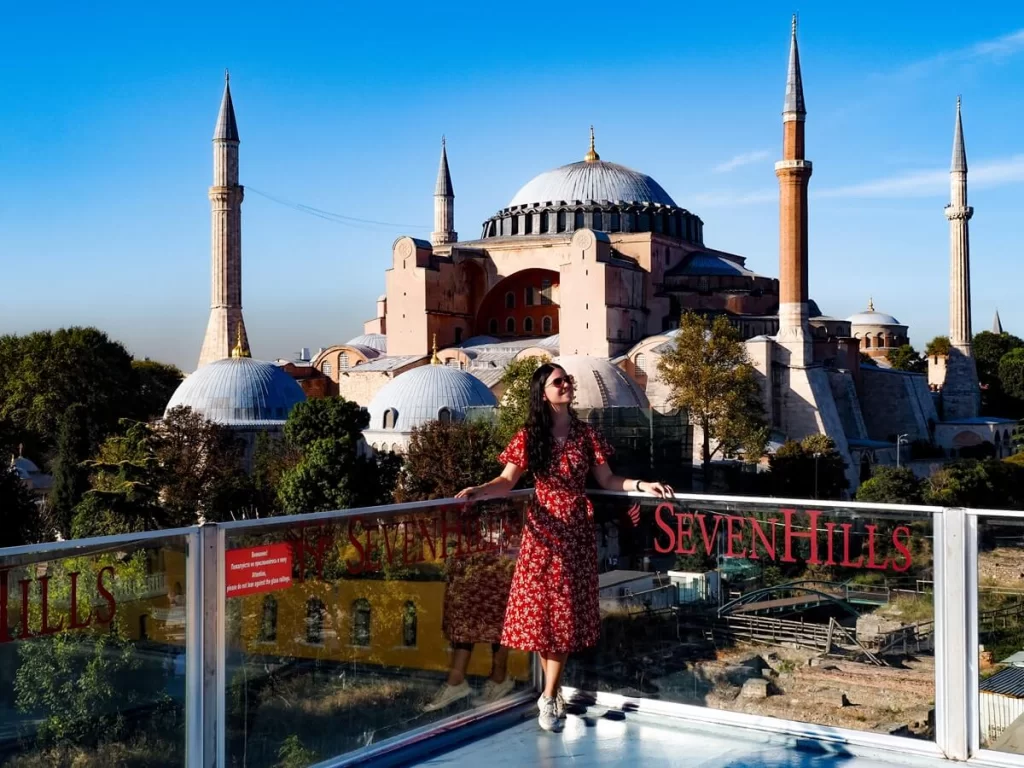
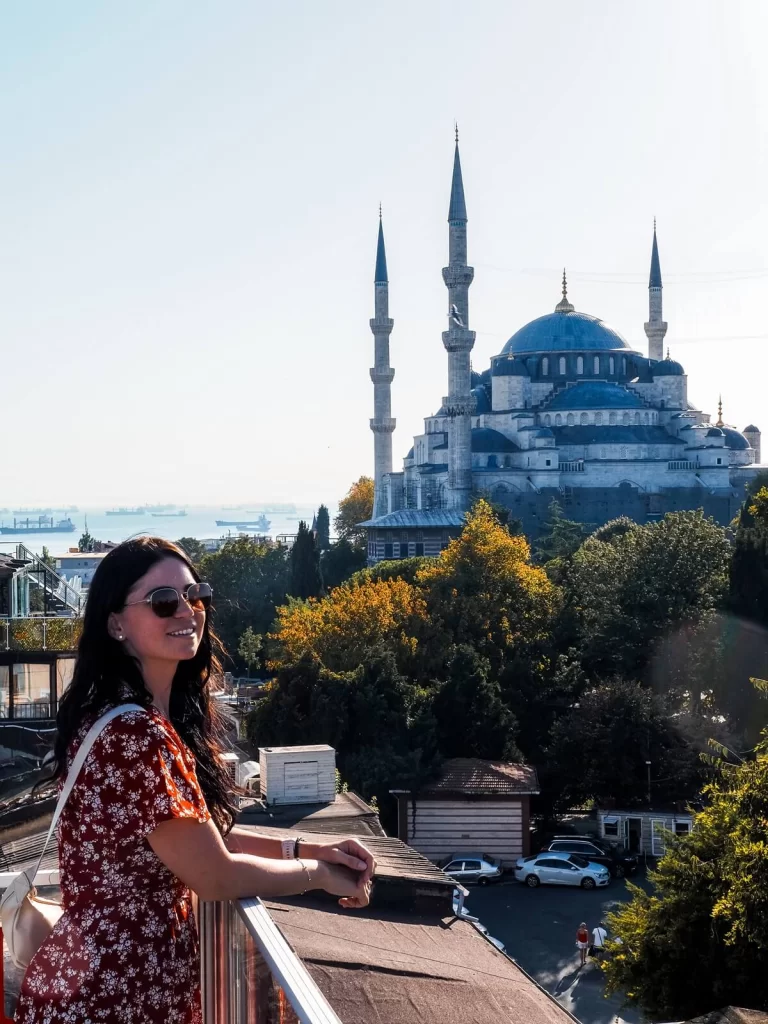
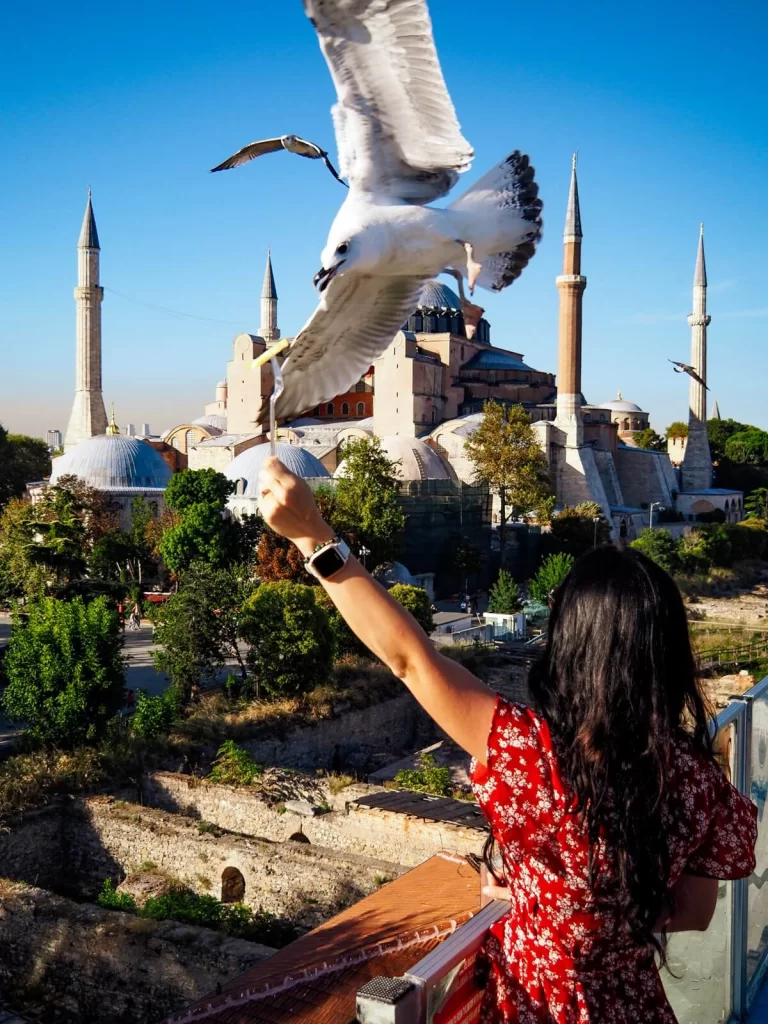
4. Seven Hills Restaurant
Istanbul has a ton of cafes and restaurants with rooftops from where you can enjoy some breathtaking city views. Seven Hills Restaurant is one of the best places to appreciate the scale of both Hagia Sophia and the Blue Mosque.
This restaurant has definitely gained a lot of attention on social media, which means that quite a few people come up here to admire the views and snap some photos. Luckily, there’s a dedicated terrace area where you can go if you’re only here for the views. This way you’re not disturbing those who want to enjoy their meal or drinks.
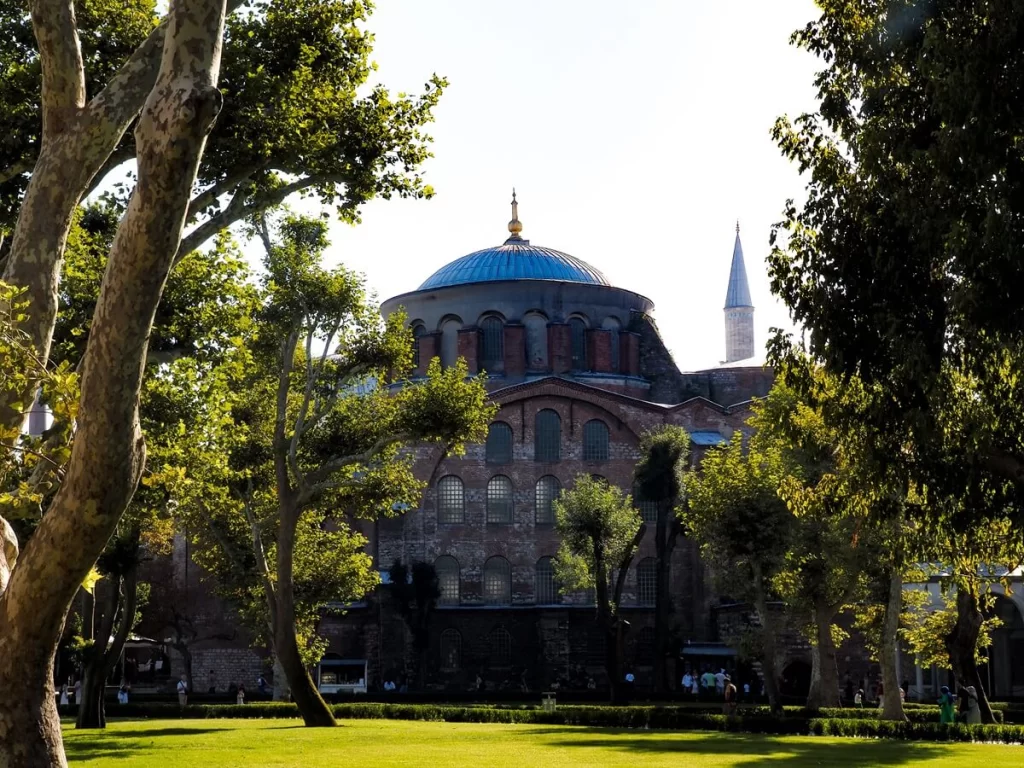
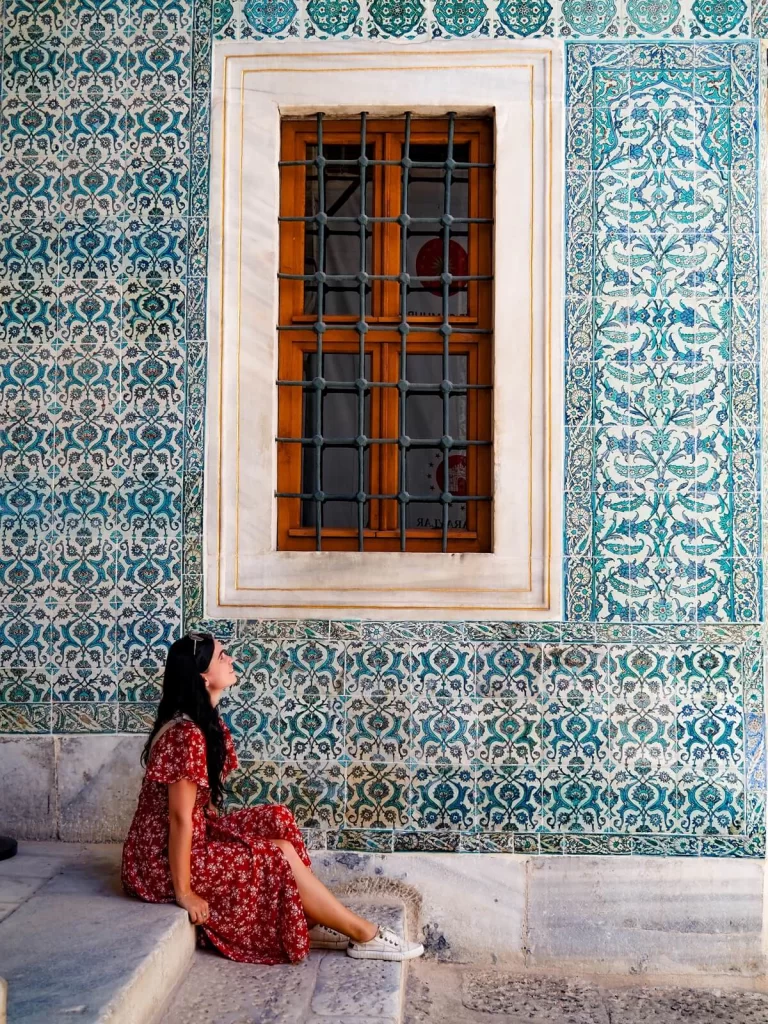

5. Topkapi Palace Museum (Topkapı Sarayı Müzesi)
Another must visit place in the Sultanahmet neighbourhood of Istanbul is Topkapi Palace Museum.
The palace was built between 1461 and 1478 by Sultan Mehmet soon after the Ottoman’s took Constantinople. It is located on the site of a Byzantine acropolis. Topkapi was the residence of the Sultans for nearly 400 years, as well as the political and administrative centre of the empire.
Topkapi Palace is a massive place and you could easily spend hours exploring it. It consists of four large courtyards, the Hagia Irene church, a treasury section, plenty of exhibition halls and the Harem. The Harem was definitely the most interesting part for us. However, we also enjoyed the other exhibition halls too.
Note. Topkapi Palace Museum is open between 9AM and 5PM. It is closed on Tuesdays. Entry is 1500TL (45 EUR) which includes entry to the Harem and Hagia Irene Church. You can also use a Museum Pass to get in.

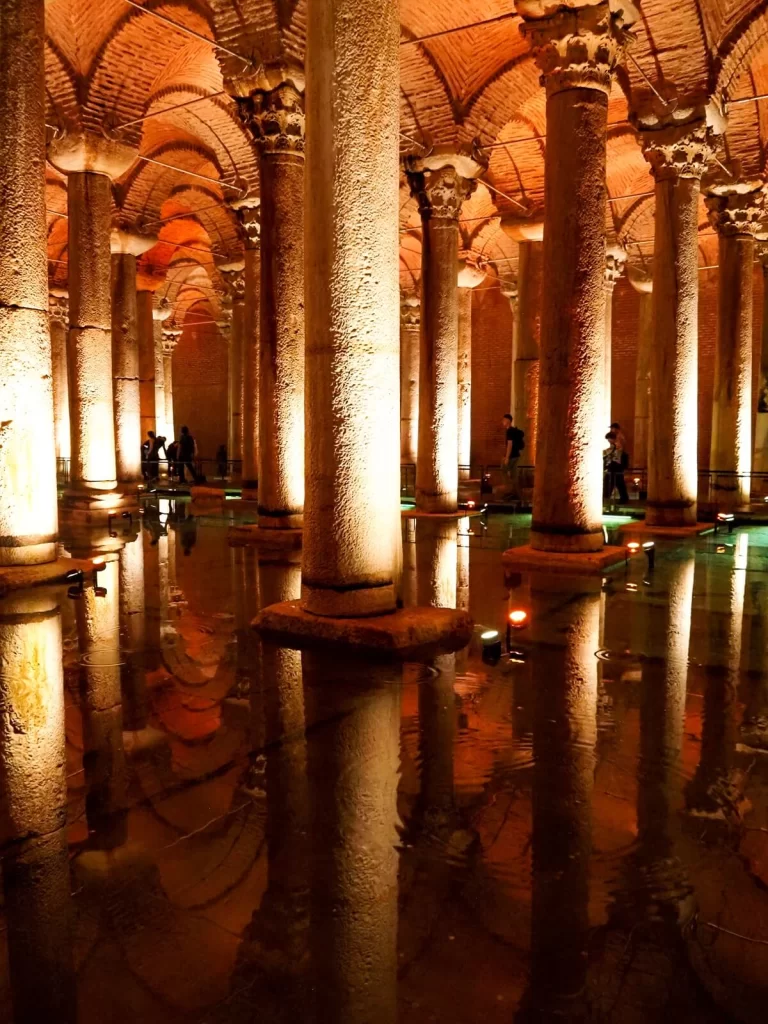
6. Basilica Cistern (Yerebatan Sarnıcı)
Did you know that underneath the streets of Istanbul there are hundreds of ancient cisterns? There are only a few open to the public today, one of which is Basilica Cistern, located just across the road from the Hagia Sophia.
The 143 m long and 65 m wide Basilica Cistern is the largest surviving Byzantine cistern in Istanbul. It was built by Emperor Justinian I in 532 AD by using 336 Ionic or Corinthian style columns to support the roof. The symmetry of this place is incredible as they placed the columns at 4 m intervals across 12 rows, with each row containing 28 columns. The purpose of the cistern was to serve the Great Palace and the surrounding area. It could hold 80.000 cubic meters of water, which was transported via an aqueduct to where it was needed.
Fun Fact. The cistern was a filming location for the 1963 James Bond film From Russia with Love.
Note. Basilica Cistern is open every day between 9AM and 10PM. Entry fee is 600TL (18 EUR). You cannot use a Museum Pass to enter.
7. Cistern of Theodosius (Şerefiye Sarnıcı)
Another ancient cistern you can visit in Istanbul is also located in the Sultanahmet neighbourhood.
The Cistern of Theodosius dates back to the 5th century and had the same purpose as the Basilica Cistern. It’s much smaller though, only about 24 by 40 m. There are only 32 columns supporting the roof arranged in 4 rows of 8 columns.
The cistern displays a lightshow every hour on the hour. They only let people in during that time, so make sure to arrive about 10 minutes before the hour if you want to avoid waiting for too long.
Note. The Cistern of Theodosius is open every day between 9AM and 7PM. Entry fee is 500TL (15 EUR). You cannot use the Museum Pass to enter.
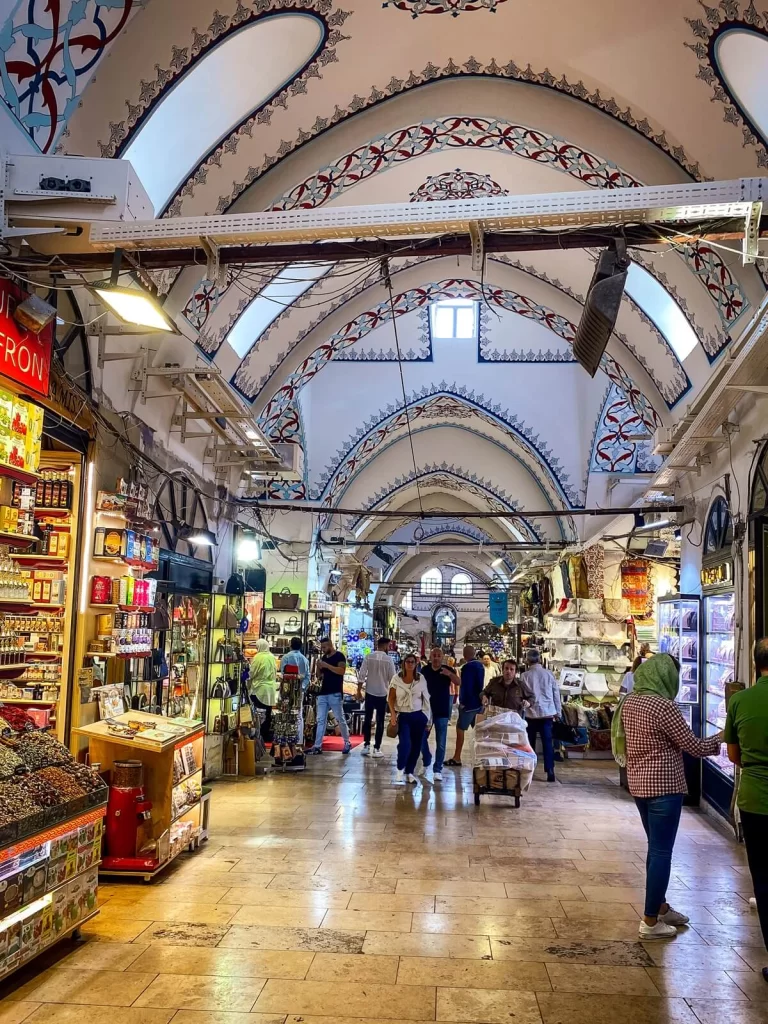
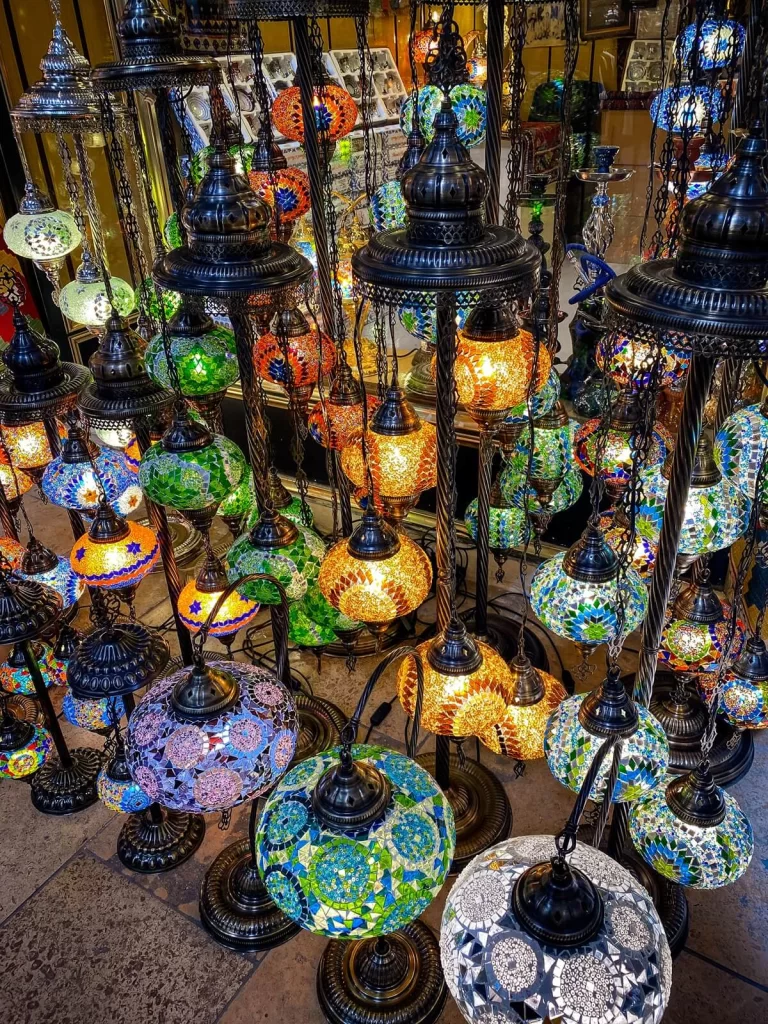
8. Grand Bazaar (Kapalı Çarşı)
No Istanbul guide would be complete without including a visit to the Grand Bazaar. If you’ve read some of our city guides before, then you know that we absolutely love visiting markets. So, as you can imagine, the Grand Bazaar had been on our bucket list for some time.
It is one of the oldest and largest covered markets in the world. Sultan Mehmet II commissioned the construction of the market soon after conquering Constantinople. The bazaar opened in 1461. Today, there are about 4,000 shops spread across nearly 60 streets. You can enter this crazy labyrinth of a market from about 20 different gates.
You can buy just about anything at the Grand Bazaar. If you’re after something memorable, then head over to the stores selling beautiful ceramics, Turkish lamps, rugs, spices, and of course Turkish Delights. However, you can also find plenty of jewellery here and a ton of knock-off versions of well-known designer brands.
Some might say it’s a massive tourist trap, and we definitely noticed that prices were generally much higher here than in other parts of Istanbul. However, the sellers were nice and happy to barter with you a little. Plus, you don’t need to buy anything if you just want to have a wander around. Whether you like shopping or not, the Grand Bazaar is an experience you have to have when you’re exploring the Sultanahmet neighbourhood of Istanbul.
Note. The Grand Bazaar is open from Monday to Saturday between 9AM and 7PM. It is closed on Sundays.
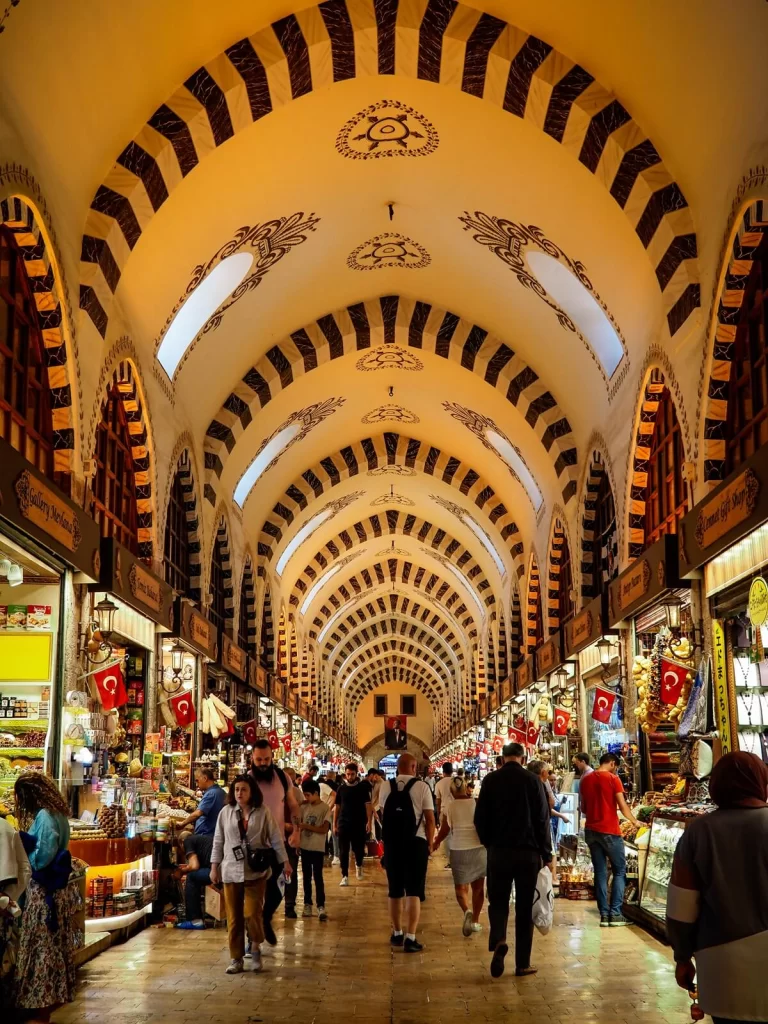
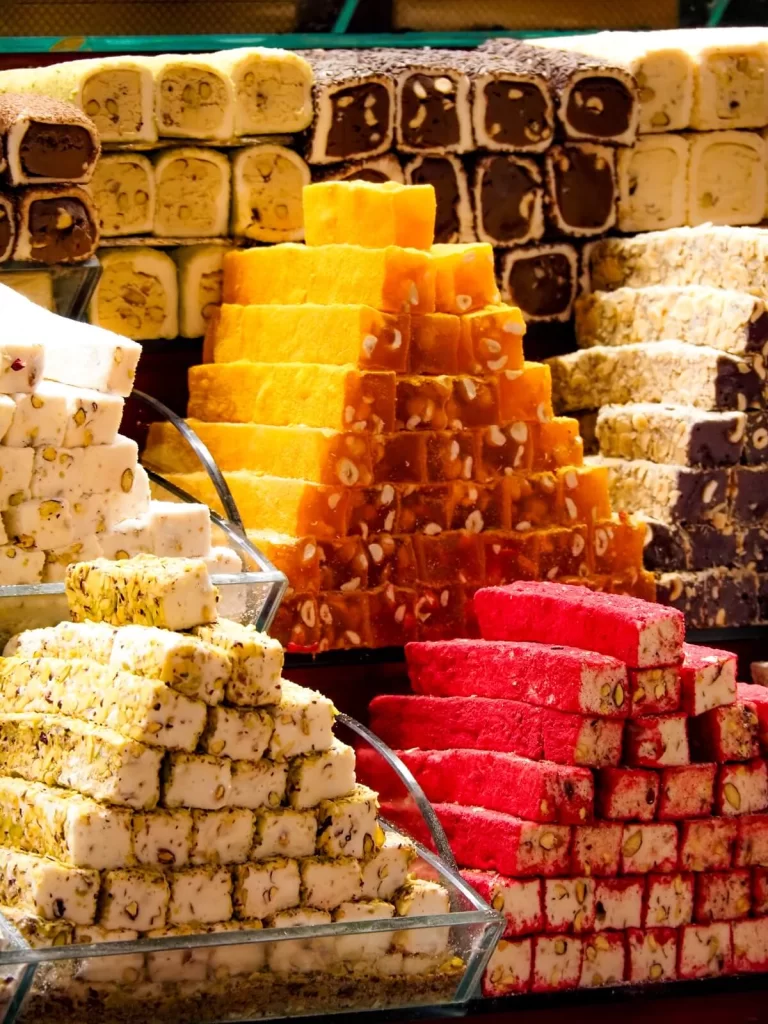

9. Egyptian Spice Bazaar (Mısır Çarşısı)
If you’re more into gastronomy, then definitely don’t miss a visit to the Egyptian Spice Bazaar. The bazaar is located in the Eminönü neighbourhood, close to Galata Bridge.
It was built in 1664, and goods imported from Egypt were mainly being sold here, which is how it got its name. Later, it began to diversify and started selling products from different countries too. Hence, it’s now sometimes just called the Spice Bazaar.
Today, it’s a popular place to buy a variety of spices, dried fruits, nuts, seeds, teas, Turkish Delight and other products, like cheeses and sausages. It is definitely a lot smaller than the Grand Bazaar, but you can still spend a good amount of time here.
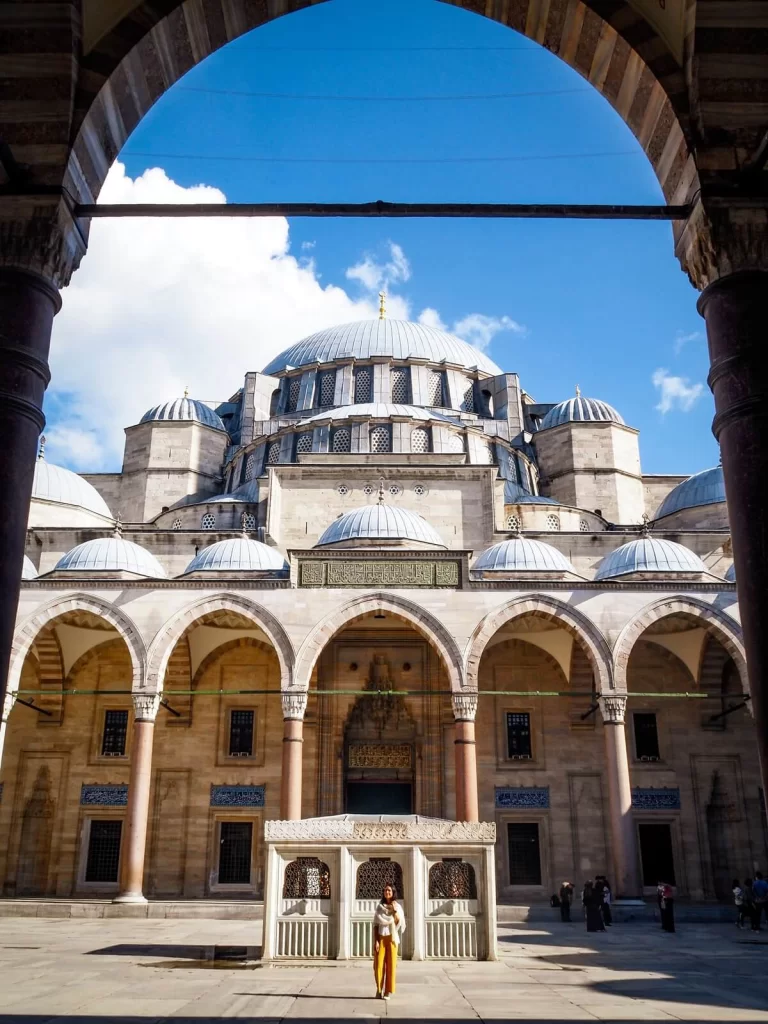
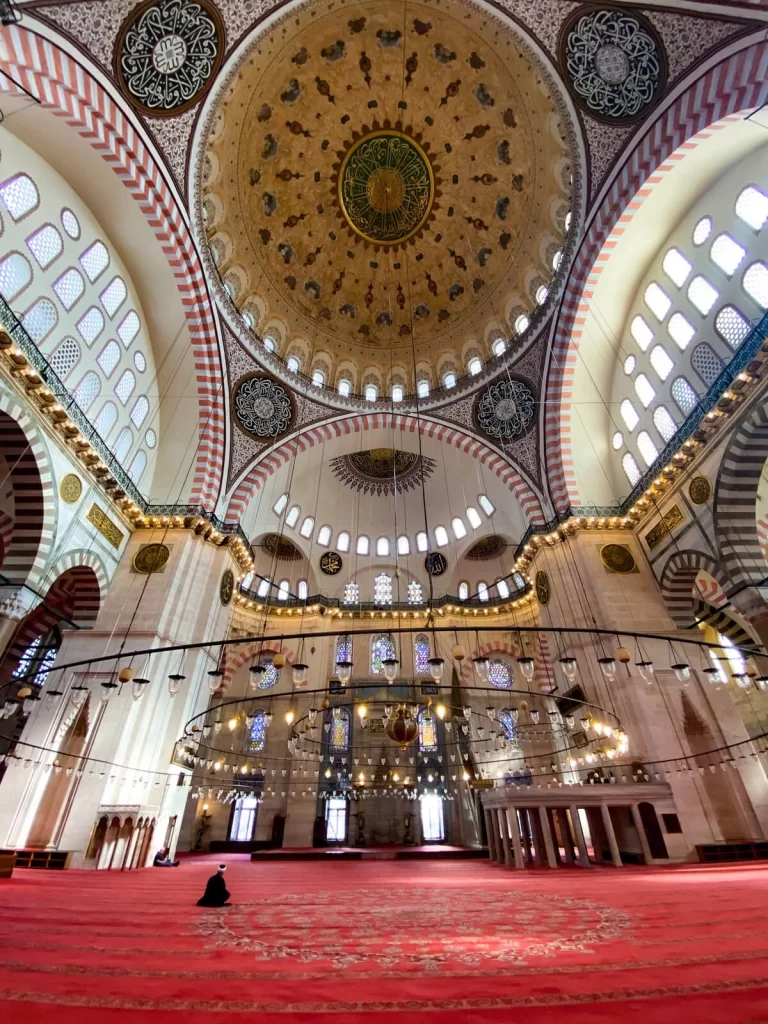
10. Süleymaniye Mosque (Süleymaniye Camii)
Situated on top of a hill in the historic district is the stunning Süleymaniye Mosque. It was completed in 1557 by Mimar Sinan, and is a tribute to Sultan Süleyman the Magnificent.
The mosque is one of Sinan’s masterpieces, and also his largest design. It has 4 minarets and a 47m high central dome. It was actually the largest mosque in Istanbul up until 2019, when that title passed to Camlica Mosque. The interior of Süleymaniye Mosque is just as beautiful, so definitely go inside if you can.
In 1660, the mosque got damaged in a fire. It was then restored by the architect Fossati but the design was changed into more of a Baroque style. During World War I, it got damaged in a fire once again and wasn’t fully restored until 1956.
Note. It is still an active place of worship. Therefore, if you want to enter, you’ll need to dress modestly and cover your hair if you’re a female.
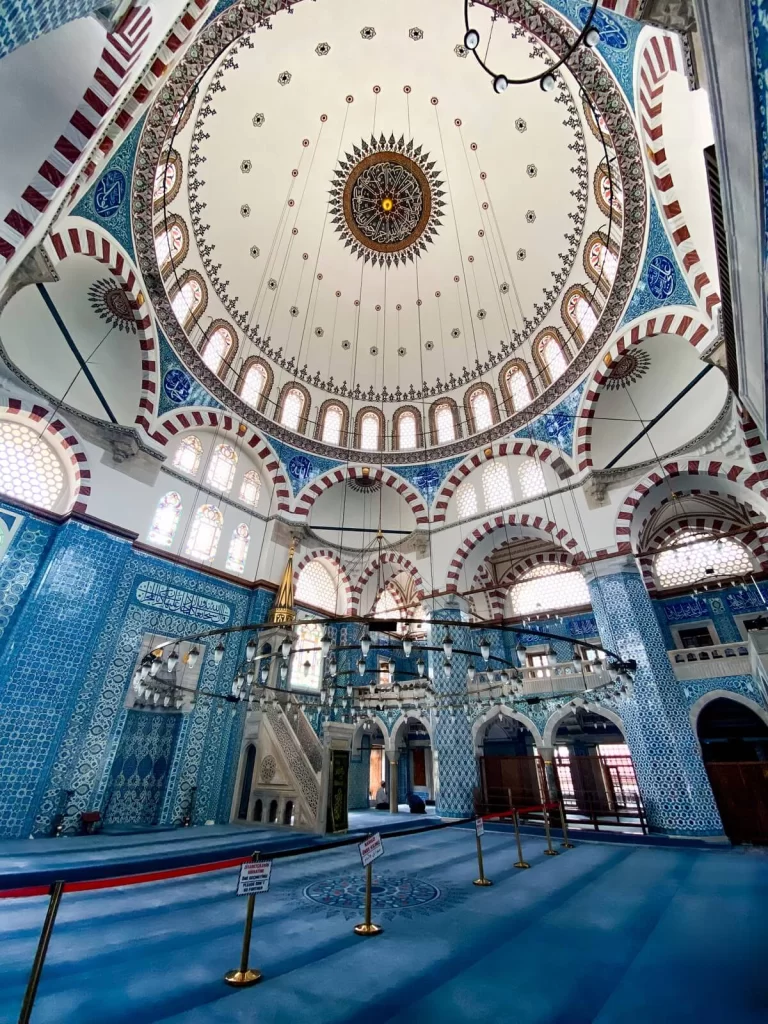
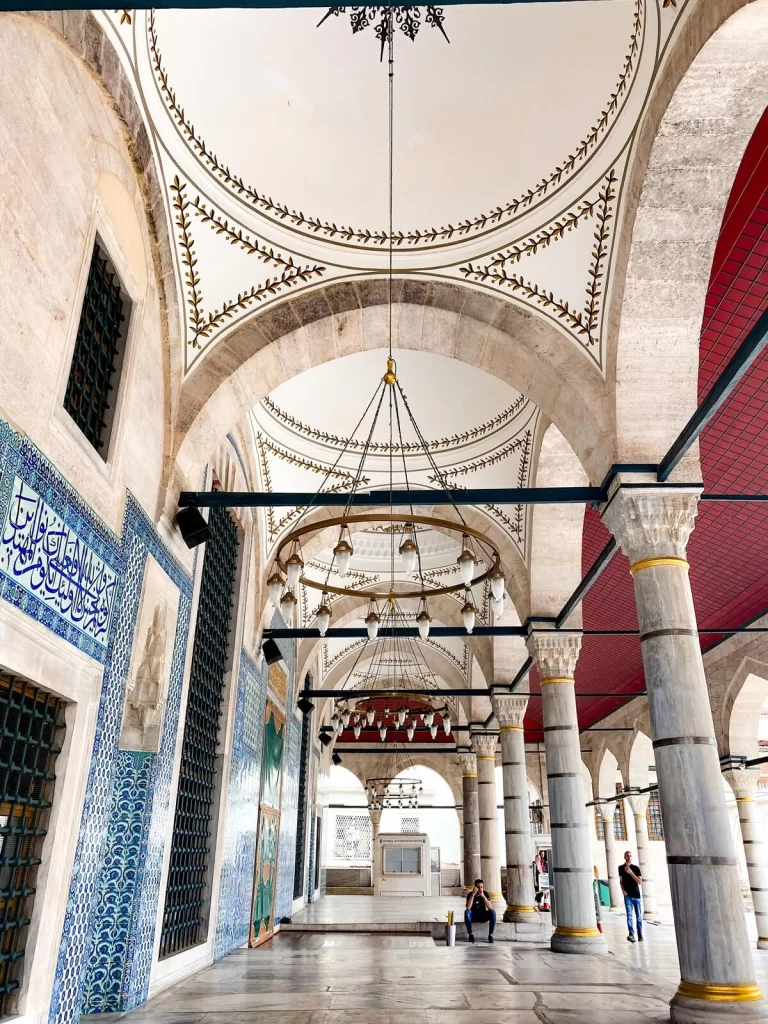
11. Rüstem Pasha Mosque (Rüstem Paşa Camii)
Another one of Mimar Sinan’s designs, Rüstem Pasha Mosque is located in the Eminönü district, close to the Spice Bazaar. He designed it for the Grand Vizier Rüstem Pasha, who was husband to one of the daughters of Suleiman the Magnificent. The design was only authorised after his death, and was completed in 1563.
Rüstem Pasha Mosque looks a bit like a smaller version of the Blue Mosque because of the blue Iznik tiles adorning its interior. The entrance isn’t the easiest to find, since it’s located within a big market (Hasırcılar Çarşısı), and you’ll initially only see a small staircase leading to the entrance. However, once you’re there we think you’ll agree it was worth the effort. It was less crowded than the Blue Mosque and still absolutely stunning inside.
Note. It is still an active place of worship. Therefore, if you want to enter, you’ll need to dress modestly and cover your hair if you’re a female.
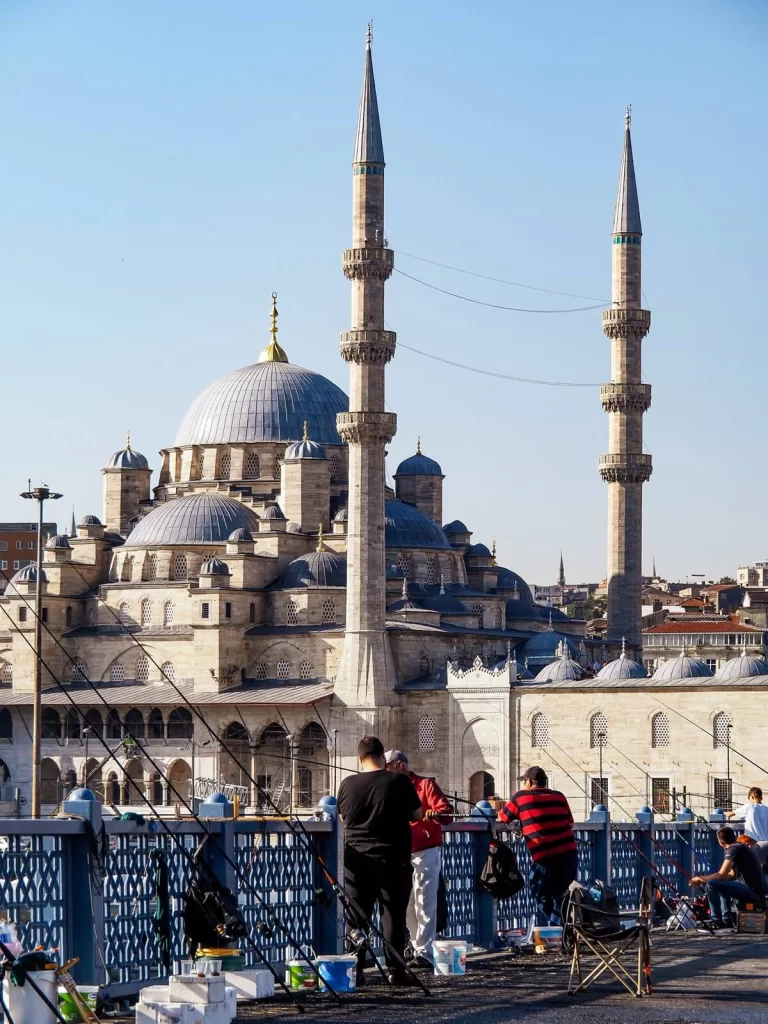
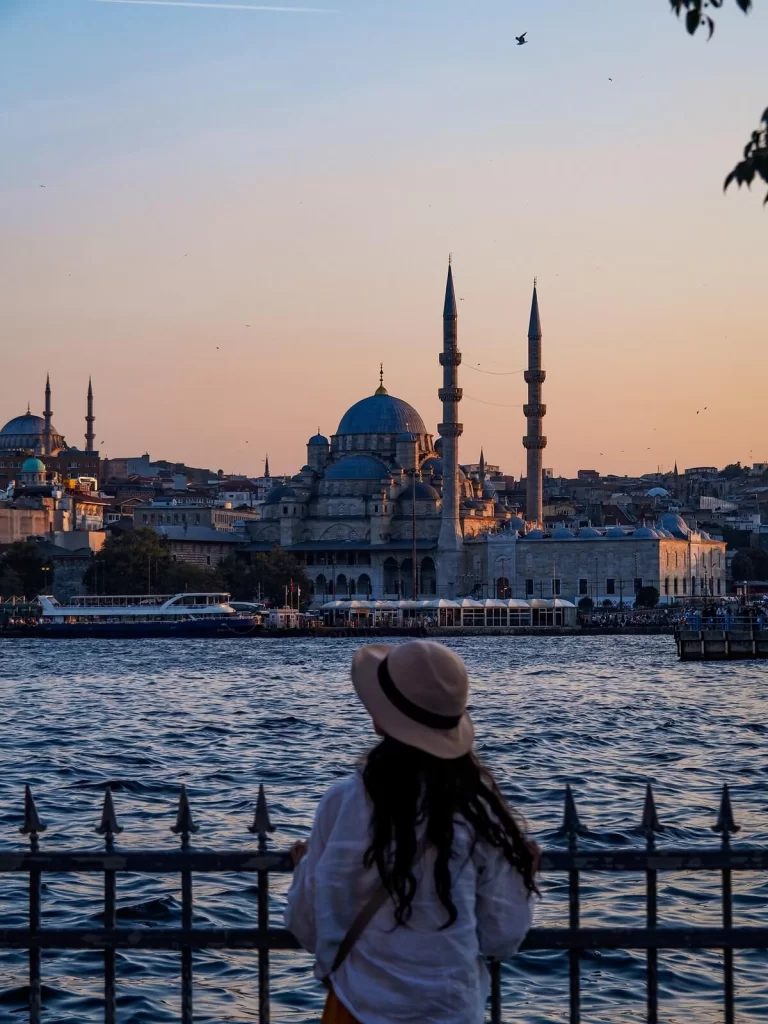
12. New Mosque (Yeni Camii)
There’s another beautiful mosque in the vicinity of Rüstem Pasha Mosque that you could add to your Sultanahmet itinerary in Istanbul. Despite the name, Yeni Camii isn’t actually a new mosque.
Safiye Sultan, the wife of Sultan Murad III and mother of Sultan Mehmed III, commissioned the building of the mosque at the end of the 16th century. However, construction stopped when the Sultan died and Safiye Sultan lost her position as the Queen Mother (Valide Sultan). Around 1660, the Queen Mother of Mehmed IV, Hadice Turhan, decided work should continue on the mosque. It was completed in 1663 using the original architect’s plan; who happened to be an apprentice of Mimar Sinan.
Note. It is still an active place of worship. Therefore, if you want to enter, you’ll need to dress modestly and cover your hair if you’re a female.
13. Turkish and Islamic Arts Museum (Türk ve İslam Eserleri Müzesi)
Housed in the Ibrahim Pasha Palace in the Sultanahmet neighbourhood is the Turkish and Islamic Arts Museum. It is the first Turkish museum dedicated to Turkish and Islamic arts.
The museum has a huge collection of Islamic artwork including ceramics, carpets, manuscripts, and woodworks. The carpet section of the museum is considered one of the richest carpet collections in the world.
Note. The museum is open every day between9AM and 5PM. Entry fee is 17 EUR. You can use a Museum Pass to enter.

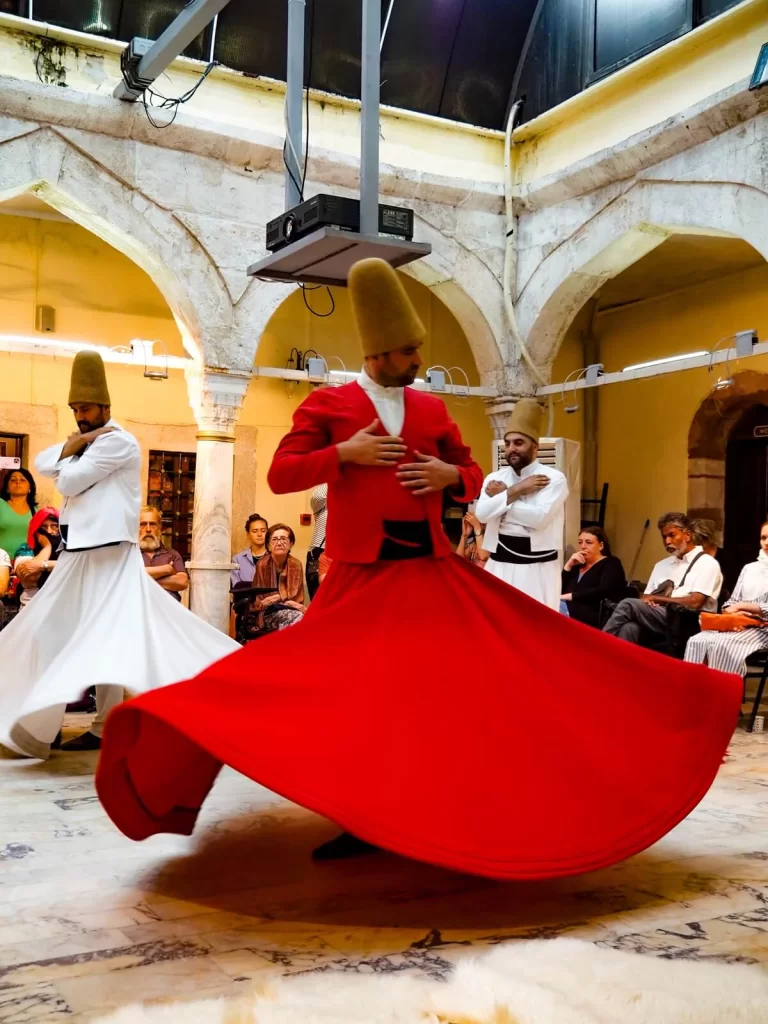
14. Whirling Dervishes Ceremony
Observing a Mevlevi Sema ceremony (Whirling Dervishes) is another fantastic thing to do when you’re in Istanbul.
The Whirling Dervishes are a religious order of Sufi Muslims founded in Konya, south of Ankara, in the 13th century. They perform a ceremony known as sema. These ceremonies were originally started as a form of meditation by Jalaluddin Rumi, who was a Sufi poet. In 1925, they were banned by Mustafa Kemal Atatürk. Then, in 1956, the Turkish government revived the ceremony as a cultural asset.
The dance is part of a spiritual ritual aimed to bring the participants closer to God. At first, the dervishes begin to whirl slowly, before gradually increasing their speed. They also raise their arms, symbolizing their submission to God.
We watched a show at the Kizlaraga Medresesi, but it probably wasn’t the most authentic experience. You can also see it at the Hodjapasha Cultural Center or the Galata Mevlevi Museum, which are probably going to be better ceremonies to watch. Note that some ceremonies may not permit photography.
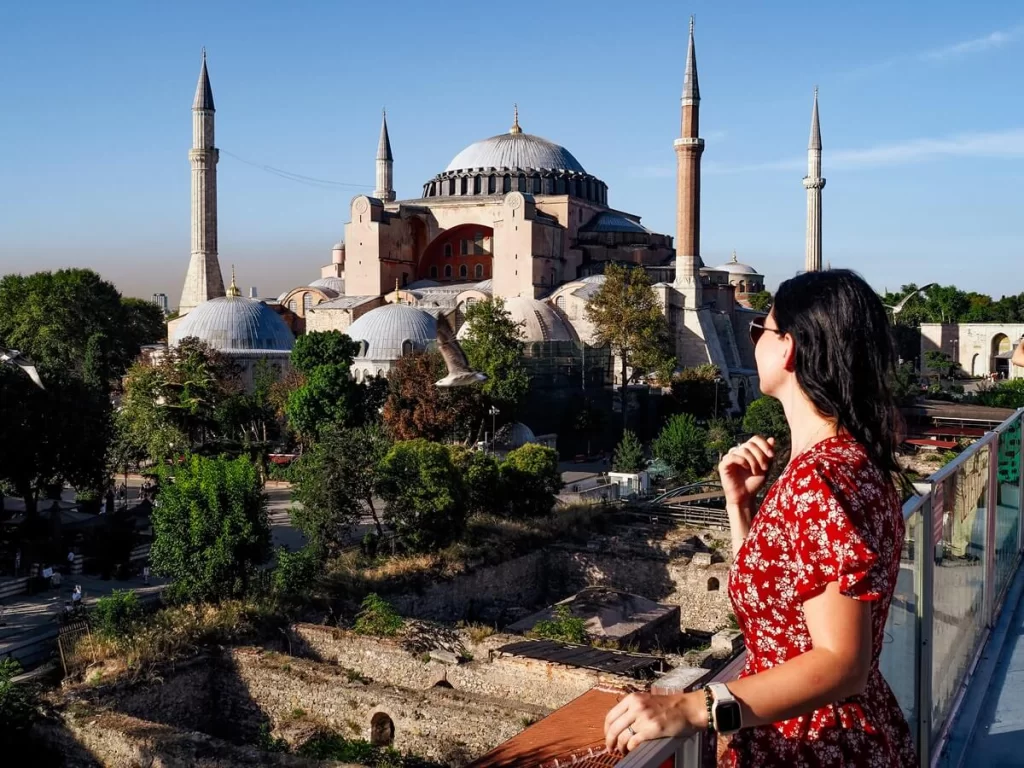
Final Thoughts on the Sultanahmet Neighbourhood of Istanbul
You won’t have any trouble spending a full day just in the Sultanahmet neighbourhood of Istanbul. In fact, you could probably spend a good chunk of your day in the Topkapi Palace Museum alone; it’s that big! This is why some people may never really get a chance to go beyond this area if they only have a short amount of time in the city.
Istanbul is a busy city, and the historic centre can become pretty crowded during the high season thanks to the huge concentration of attractions there. We definitely had to queue to get into places, so we recommend starting your day as early as possible.
Have you ever been to Istanbul before? If so, how much of the Sultanahmet neighbourhood did you manage to see? What was your favourite place? If not, what would you add to your itinerary? Let us know in the comments below.
Now, let your adventure begin,

Our Top Travel Resources
Accommodation: For hotels we always use Booking.com and Hostelworld for hostels. We also book longer stays on Airbnb or Vrbo.
Flights: To find the best flight prices we always check Skyscanner, Google Flights or WayAway. Then we also check the airlines’ websites too for comparison.
Car Rentals: We use Discover Cars when we want to rent a car as it compares local, national and international companies.
Activities: If we book organised tours we always check either GetYourGuide or Viator.
Foreign Currency: Whenever we can we prefer to pay in local currency and for that we always use our Wise card. We can easily withdraw money from the ATM or pay by card at most shops and restaurants.
Travel Insurance: We never go anywhere without travel insurance. You never know what will happen on your trip, so good travel insurance like SafetyWing can protect you in case of injury, illness, theft and cancellations.
eSIM and VPN: To get data abroad we use Airalo which is an app that allows you to download a prepaid eSIM to your phone in over 190 countries. Make sure to have a VPN to avoid hackers accessing your personal data when using public WIFI. We use Surfshark which is the only VPN that offers one account on unlimited devices.

